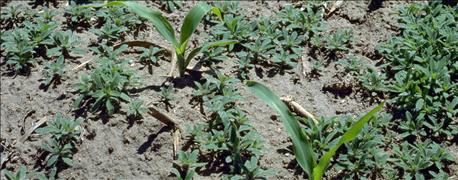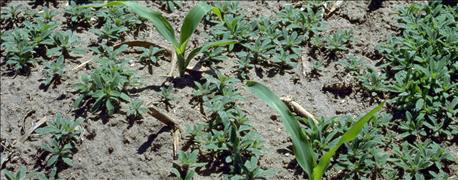November 14, 2016

Kochia is a tough weed to control, but it has one big weakness.
Do you know what the weakness is?
Kochia seed is viable for only one or two years. Rotating to a grass crop, for which there are many herbicides registered, can help you control kochia and deplete the soil seed bank.
Eight other facts to know about kochia are:
1. Kochia has wide genetic diversity. There are green-, red- and purple-colored plants, tall and narrow plants, short and round plants, and plants with wide leaves, and narrow leaves. Wide genetic diversity caused ALS-resistant kochia biotypes (Group 2) to develop in the late 1980s, a short time after ALS herbicides were developed.

TOUGH WEED: Kochia is a difficult weed to control because it is resistant to many types of herbicides. (Photo: Phil Westra, Colorado State University, Bugwood.org)
2. Most kochia plants emerge in a two- to three-week time span very early in the spring. However, early-spring tillage and herbicide burndown practices have selected for later-emerging kochia biotypes. As a result, multiple flushes of kochia now occur from April through July.
3. Kochia is well adapted to drought conditions and saline soil. It grows fastest when it doesn’t have competition from other plants.
4. Kochia has one of the highest seed-to-plant mass ratios, and the seed is weakly attached to the plants. When the plant stem dries out and breaks in the fall, the plant is blown across fields, and the seed is spread. Unfortunately, most fences around fields have been removed, and more field shelterbelts are being taken out. They use to prevent kochia from spreading.
5. Though kochia pollinates itself, it can also cross pollinate. That is one of the ways that herbicide resistance spreads.
6. Kochia in North Dakota is resistant to the following herbicide groups:
• Group 2 (ALS) = Express, Raptor, Python, etc.
• Group 4 (growth regulator) = 2,4-D, dicamba, Starane
• Group 5 (photosynthetic inhibitor) = atrazine
• Group 9 (EPSPS inhibitor) = glyphosate. The mechanism of glyphosate resistance in kochia is gene amplification (i.e., plants make multiple copies of the EPSPS gene). Gene amplification can produce kochia that cannot be controlled by practical rates of glyphosate.
7. A kochia plant can possess resistance to several different herbicide groups at the same time.
8. The most effective chemical control strategy for kochia includes applying preemergent followed by postemergent herbicides. Many preemergent corn and soybean herbicides can effectively control kochia, if activated by rain. Except for corn and small grains, all other crops have very few postemergent herbicides to effectively control kochia. Timely postemergent applications to small kochia are required for maximum activity. Herbicides for kochia control in corn and soybeans include:
• Corn: atrazine, dicamba, flumioxazin, fluroxypyr, isoxaflutole, mesotrione/tembotrione/topramezone + atrazine, pyroxasulfone, saflufenacil, and Liberty in LibertyLink corn.
• Soybean: bentazon + MSO adjuvant (split applications, flumioxazin, fomesafen, metribuzin, sulfentrazone, saflufenacil and Liberty (LL corn).
The North Dakota State University Extension Service’s Weed Guide is the source of this information.
You May Also Like




